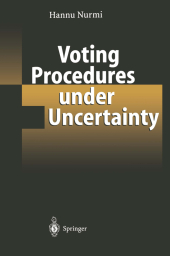 Neuerscheinungen 2012Stand: 2020-01-07 |
Schnellsuche
ISBN/Stichwort/Autor
|
Herderstraße 10
10625 Berlin
Tel.: 030 315 714 16
Fax 030 315 714 14
info@buchspektrum.de |

Hannu Nurmi
Voting Procedures under Uncertainty
2012. x, 156 S. 1 SW-Abb., 44 Tabellen. 235 mm
Verlag/Jahr: SPRINGER, BERLIN 2012
ISBN: 3-642-53500-3 (3642535003)
Neue ISBN: 978-3-642-53500-0 (9783642535000)
Preis und Lieferzeit: Bitte klicken
We live in an uncertain world, is a truism most of us hear more often than we would like. What one usually means to say by this is that we do not know what will happen in the future. Since changes, even major ones, have occurred in the past, it is possible that they will occur again in the future. In politics institutions are ways of coping with continuity and change. In democratic systems the electoral institutions provide ways of peaceful adjustment to changes in popular opinions. This book is about uncertainty as it pertains to electoral institutions. We shall deal with the ways in which analytic models are capable of taking into account voter uncertainty, ignorance and incompetence. We shall also discuss how uncertainty pertains to electoral outcomes. Given voter opinions, there is often a wide variation in the possible electoral outcomes. This could be called procedure-dependence of outcomes. Its existence shows that uncertainty is not something that can characterize only future events. It can pertain to past ones as well. This work is part of the Democracy and Constitution Project of Center for Business and Policy Studies (SNS). The idea of writing a book on the performance of voting procedures under uncertain cir cumstances came up in my correspondence with Dr. Per Molander of SNS a few years ago.
1. Choice Theory and Constitutional Design.- 1.1 Theories and Models.- 1.2 Applying Social Choice Theory.- 1.3 Varying Assumptions.- 2. Chaotic Behavior of Models.- 2.1 The U.S. Presidential Elections.- 2.2 Referendum Paradox and the Properties of Majority Rule.- 2.3 How Chaotic Can It Get?.- 3. Results Based on Standard Model.- 3.1 Voting Procedures.- 3.2 Performance Criteria.- 3.3 Chaos, Strategy and Self Correction.- 4. Aggregating Voting Probabilities and Judgments.- 4.1 Avoiding Arrow´s Theorem via Average Rule.- 4.2 Condorcet´s Jury Theorem.- 4.3 Relaxing the Independence Assumption.- 4.4 Optimal Jury Decision Making.- 4.5 Thought Experiment: Council of Ministers as a Jury.- 5. Condorcet´s Rule and Preference Proximity.- 5.1 Condorcet´s Rule.- 5.2 Measuring Preference Similarity.- 5.3 Preference Proximity and Other Desiderata.- 5.4 Ranking and Choice Rules.- 5.5 Kemeny, Dodgson and Slater.- 6. Responses to Changes in Voter Opinions.- 6.1 Monotonicity, Maskin-Monotonicity and No-Show Paradox 92.- 6.2 The Strong No-Show Paradox.- 6.3 Qualified Majorities and No-Show Paradox.- 6.4 Monotonicity Violations of Voting Systems.- 6.5 Preference Truncation Paradox.- 6.6 Preference Misrepresentation.- 7. Mos Docendi Geometricus.- 7.1 The British Parliamentary Elections of 2001.- 7.2 Critique of Condorcet´s Intuition.- 7.3 Profile Decomposition.- 7.4 Berlin vs. Bonn Vote Revisited.- 8. Conclusions.- List of Figures 139 List of Tables.- Author Index.


